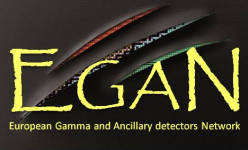Speaker
Eiji UEGAKI
(Dept. of Mech. Engineering, Akita Univ., Japan)
Description
High-spin resonances well above the Coulomb barrier in 24Mg+24Mg and 28Si+28Si systems exhibit many narrow and prominent peaks correlated among the elastic and inelastic channels, which suggest rather long-lived compound systems and offer intriguing subjects in nuclear physics. Angular correlation measurements for 28Si+28Si made with 4π gamma detectors have provided crucially important information on resonances. Characteristic features of the experiments are following three points; 1) the resonance at Ecm=55.8MeV decays to the inelastic channels as single and mutual 2+ even more strongly than the elastic one. 2) angular distributions in those channels indicate a dominance of a single orbital angular momentum L=J=38. 3) the angular correlations of the fragments 28Si and γ-rays emitted from the fragments indicate that the intrinsic spins of the constituent nuclei are in the reaction plane. The latter two show a dis-alignment between the orbital angular momentum and the fragments spins. By using a molecular model the authors investigated an equilibrium configuration of interacting two oblate nuclei, and showed it to be the equator-equator one. Couplings among various molecular configurations are taken into account by the method of normal mode around the equilibrium, which gives rise to the molecular modes of excitation such as butterfly motion. These excitations exist over the range of spin J=34~40 in which the equator-equator onfiguration is stable, and are expected to be the origin of the narrow resonances. Decay properties of the molecular states including spin alignments have been investigated to know which kinds of the molecular modes are consistent with the resonances observed. At the resonance energy Ecm=55.8MeV, very strong excitations are seen in both the single 2+ and mutual 2+ excitations. However the normal-mode excitations exhibit strong yields to the mutual 2+ channel, but weak enhancements to the single 2+ channel, and thus do not fit well. Only the molecular ground state appears to follow those decay characteristics. Since the equilibrium configuration is triaxial, rotations of the total system induce mixing of K-quantum numbers, which is consistent with the angular correlations measured as well as the dis-alignments. At a given angular momentum J, this configuration rotates in a triaxial way preferentially about the axis corresponding to the largest moment of inertia in the state with the lowest energy. Therefore the whole system rotates about the normal to the plane defined by the two pancake-like 28Si nuclei. The spins of the 28Si fragments are thus in this plane since no rotation can occur about the symmetry axes of 28Si. Thus the angular correlations are very well reproduced with the molecular ground state as well as the fragment angular distributions. In conclusion, study of the 28Si+28Si system by the dinuclear molecular model gives variety of molecular states. In them the molecular ground state with J=38 is a candidate for the resonance at Ecm=55.8MeV. For systematic study for excitations of the molecular modes, the same kind of information on the other nearby resonances of 28Si+28Si is strongly called for.
Primary author
Eiji UEGAKI
(Dept. of Mech. Engineering, Akita Univ., Japan)
Co-author
Dr
Yasuhisa ABE
(RCNP, Osaka University, Japan)

